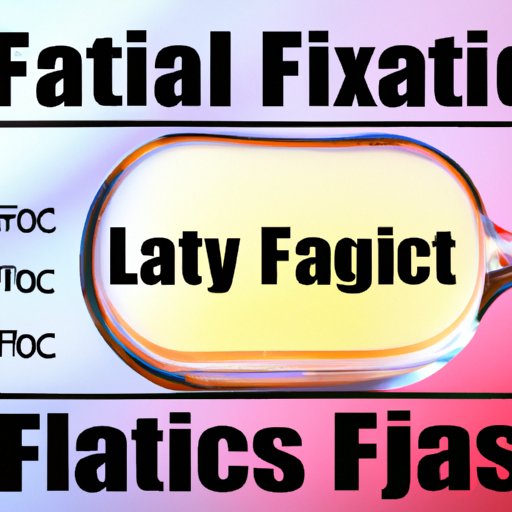
Introduction
Weight loss is a common goal for many people, but what happens to the extra fat in your body when you start losing weight? This is a question that many often overlook, leaving them with a sense of confusion when the numbers on the scale begin to decrease. In this article, we’ll provide you with a comprehensive guide on what really happens to fat when you shed pounds.
The Science Behind Weight Loss: Understanding How Fat Disappears from Your Body
Before diving into the specifics of fat loss, it’s important to understand how weight loss works in general. When you consume calories, your body uses some as energy and stores the rest as fat. Weight loss occurs when you burn more calories than you consume, creating a calorie deficit. This deficit forces your body to turn to stored energy (i.e., fat) to fuel itself.
In simple terms, weight loss is about balancing the calories you consume with the calories you burn or expend each day. This is known as energy balance. When you’re in an energy deficit, your body begins to break down fat to make up for the energy deficiency.
Your metabolism, or the processes that convert food into energy, also plays a significant role in weight loss. A higher metabolism means your body burns calories faster, which can lead to more efficient fat loss.
What Really Happens to Fat When You Shed Pounds: A Comprehensive Guide
When you lose weight, your body must break down the stored fat into energy to fuel your body. The process by which your body breaks down fat stores is called lipolysis. This process involves many different hormones, each with a specific function.
The fat breakdown process begins with the hormone epinephrine, which signals the breakdown of triglycerides (fat storage) into glycerol and fatty acids. The glycerol portion of this breakdown can be converted into energy by the liver, while the fatty acids can be used as energy directly by the body. From here, the transportation of fatty acids into the cells to produce energy for movement and other body functions continues.
In addition to epinephrine, hormone-sensitive lipase (HSL) plays a crucial role in the fat breakdown process. HSL acts as an enzyme that breaks down triglycerides into glycerol and free fatty acids. These fatty acids can travel through the blood to various parts of the body to be utilized as energy.
Once the fat has been broken down, the fatty acids can be easily transported by the blood to the mitochondria of cells, where they can be used for energy production.
From Lipids to Energy: Exploring the Fate of Fat during Weight Loss
When it comes to burning fat for fuel, there are multiple energy systems at play in the body, including the aerobic and anaerobic systems. The aerobic system relies primarily on oxygen to convert fat stores into energy, while the anaerobic system uses no oxygen.
The aerobic system is used for prolonged and steady-state exercise such as walking or jogging. During these exercises, the body utilizes the required oxygen to break down fat into carbon dioxide and water. These byproducts of the process are then exhaled and perspired out of the body respectively.
Breaking down fat into energy causes the release of carbon dioxide, which is then exhaled. When atoms of oxygen bind with these carbon atoms, they form carbon dioxide which is then exhaled through the lungs. This is why, when you lose weight, you breathe out more carbon dioxide than usual as the fat stores leave your body.
Breaking Down the Mechanics of Fat Loss: Where Does Your Body Fat Actually Go?
When you shed weight, the fat itself doesn’t exactly “burn” away into nothingness. Instead, it is broken down into smaller compounds and substances that can be excreted by the body.
The body’s primary excretory systems are the lungs, liver, and kidneys. While a small amount of fatty acids and glycerol is released through urine and sweat, the liver processes the majority of the byproducts of fat breakdown. Specifically, the liver transforms excess fatty acids into ketone bodies. These ketones can then cross the blood-brain barrier, ultimately being used by the brain and other organs as fuel.
The Journey of Fat: Tracing the Transformation from Excess Fat to Weight Loss
It’s important to note that not all fat storage in the body is the same and thus, not every person has the same “problem areas.” In general, men tend to carry more fat in their abdominal areas, while women are more likely to carry fat in their hips, thighs, and buttocks. Understanding fat distribution and storage is important because it affects how weight loss is seen on the body.
When weight loss occurs, the body doesn’t burn just one type of fat stores, but rather a mixture of the different types that exist. The body targets excess fat stores from all areas of the body, but this can create a variance in how the weight loss is seen on the body.
The rate in which the body burns stored fat also varies based on many factors such as diet, exercise, genetics, and overall health. Muscle mass, age, and hormonal imbalances also affect an individual’s ability to burn fat.
Conclusion
Knowing what happens to fat when you lose weight is essential for effective and healthy weight loss. By understanding the science behind fat loss, individuals can achieve better results by manipulating their diet and exercise routines in a more efficient way.
Key takeaways for those looking to lose weight include focusing on creating an energy deficit, increasing metabolism through exercise, and choosing nutrient-rich, whole foods. Understanding and targeting problem areas can promote optimal fat loss, leading to long-term health benefits and an overall healthier lifestyle.
Overall, the fate of fat during weight loss is a complex and fascinating process that demands attention and deeper research. But with patience and dedication, anyone can achieve their weight loss goals and improve their overall health and well-being.




